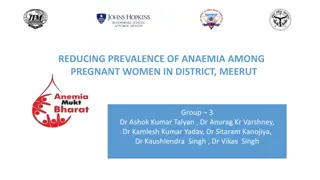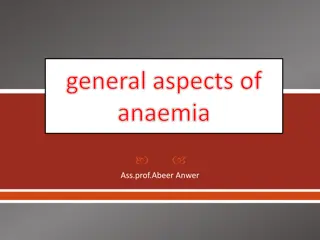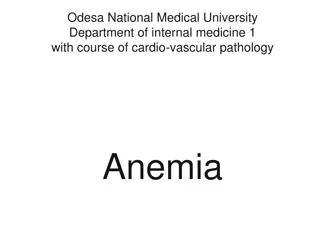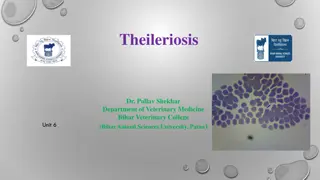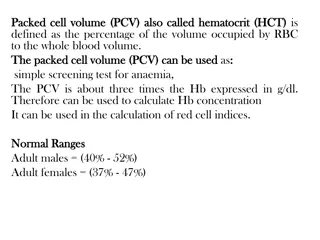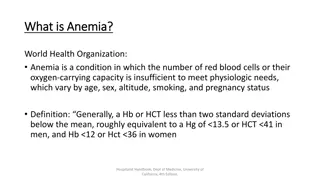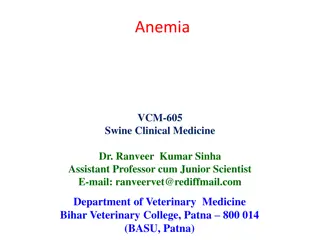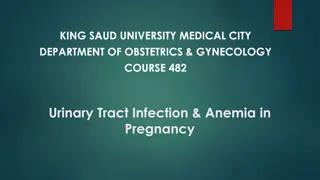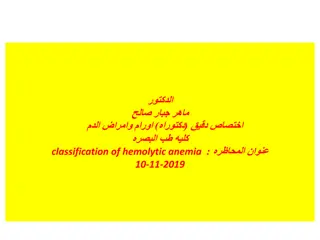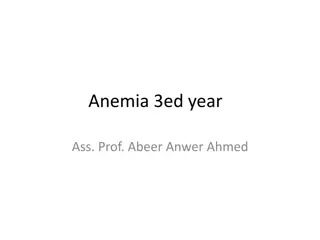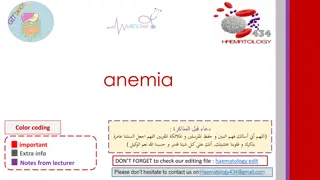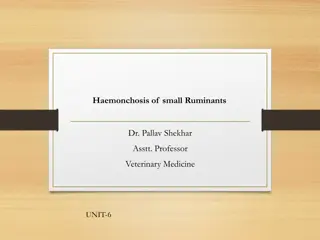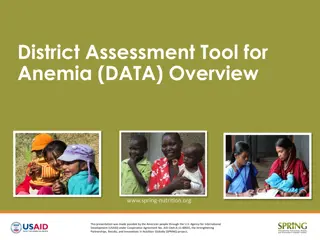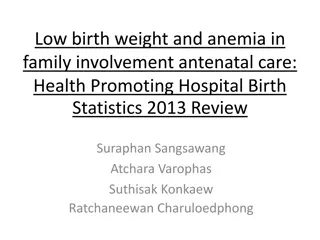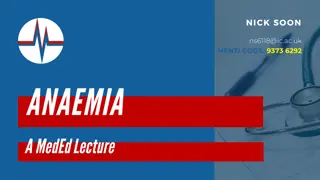Understanding Anemia: Causes, Types, and Prevention
Anemia occurs when there are not enough red blood cells in the body, leading to symptoms like fatigue, rapid heartbeat, and pale skin. Causes include nutrient deficiencies, interfering substances, and poor environmental conditions. Different types of anemia such as hypochromic, megaloblastic, and dimorphic have specific characteristics. Prevention strategies include a balanced diet, supplementation, education, and fortification to address iron deficiency.
Download Presentation

Please find below an Image/Link to download the presentation.
The content on the website is provided AS IS for your information and personal use only. It may not be sold, licensed, or shared on other websites without obtaining consent from the author. Download presentation by click this link. If you encounter any issues during the download, it is possible that the publisher has removed the file from their server.
E N D
Presentation Transcript
COMMUNITY NUTRITION COMMUNITY NUTRITION JESUS ROSALIND ASSISTANT PROFESSOR OF FOOD SCIENCE
ANEAMIA Anemia happens when there are not enough red blood cells in your body. Red blood cells carry oxygen through your bloodstream, giving you energy and helping your muscles, bones, and organs work properly.
SYMPTOMS COMMON TO MANY TYPES OF ANEMIA INCLUDE THE FOLLOWING: Easy fatigue and loss of energy Unusually rapid heart beat, particularly with exercise Shortness of breath and headache, particularly with exercise Difficulty concentrating Dizziness Pale skin Leg cramps Insomnia
CAUSES Deficient in nutrient intake such as iron, folate, vitamin B complex, vitamin C, protein. Interfering substance: tea, coffee, phytate. Menstruation, child birth, hookworm infestation. Poor environment: water, sanitation, food hygiene. Inadequate diet in quantity / quality.
TYPES Hypochromic and microcytic anaemia Megaloblastic anaemia Dimorpic anaemia
HYPOCHROMIC AND MICROCYTIC ANAEMIA There is insufficiency of iron for the formation haemoglobin. The RBC are pale, small.
MEGALOBLISTIC ANAEMIA o Maturation of RBC in the bone marrow are impaired by lack of folate, or vitamin B12, the cells which enter the blood stream are irregular in shape and size, but lager than normal.
DIMORPIC ANAEMIA Both iron, either folate or vitamin B12 are deficient.
PREVENTION Diet Supplementation Education Fortification
DIET Diet should rich in iron, protein, vitamins and minerals.
SUPPLEMENTATION Expectant &nursing mothers -60mg of iron and 0.5mg of folic acid. Children(1-5yrs) 20mg iron and 0.1mg folic acid.
EDUCATION All medical, health, and social workers horticulture department and voluntary organisations have roles in play in promoting the consumption of iron rich foods.
FORTIFICATION Fortification of a commonly consumed food item with iron has been considered as one of the practical approaches for the prevention and control of iron deficiency anaemia
TREATMENT Hydroxycobalamin-1000mcg twice during first week. 250 mcg weekly 1000 mcg every 6 weeks Folic acid used treatment of pernicious anemia Vit-b12 level in maternal milk and serum are low in pernicious anemia it is corrected by giving single dose of 50 micro gram of vit-b12 to the mother or to the infant.
REFERENCE https://www.who.int/topics/anaemia/en/ https://en.wikipedia.org/wiki/Anemia https://www.medicalnewstoday.com/articles/158800.php https://www.webmd.com A to Z Guides Reference https://www.emedicinehealth.com/anemia/article_em.htm https://www.betterhealth.vic.gov.au/health/conditionsandtr eatments/anaemia https://www.nhsinform.scot/illnesses-and- conditions/.../iron-deficiency-anaemia




